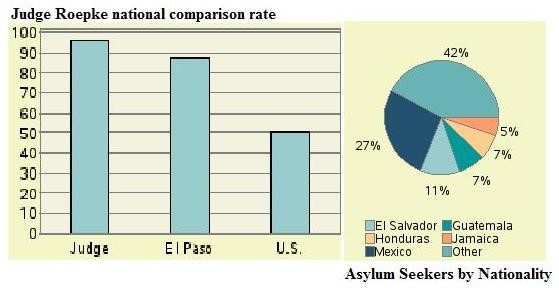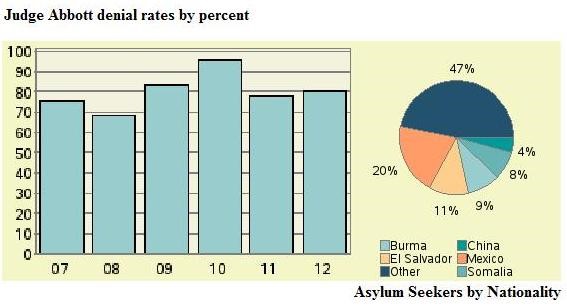
Judge Thomas C. Roepke’s denial rate compared to El Paso’s and the U.S. rate for years 2007 through 2012. Source: TRAC.
EL PASO — Only 1.6 percent of Mexicans seeking political asylum in the United States have been approved in the last five years, while the national approval rate during this same time for all asylum requests was 49.4 percent.
Approval rates for asylum cases vary by district and according to national statistics two of six immigration judges in El Paso have among the lowest asylum approval rates in the nation. Judge William L. Abbott denied asylum requests to 80.1 percent of applicants and Judge Thomas C. Roepke’s denial rate is 96.3 percent.
The Transactional Records Access Clearinghouse (TRAC), a nonpartisan center based at Syracuse University, tracks the enforcement activities of the federal government. TRAC analyzed the decisions of 273 immigration judges that have ruled in at least 100 political asylum cases in the last five years. The analysis of the decisions by United States immigration court judges in El Paso found that Roepke has the 4th highest denial rate in the nation while Abbott has the 47th highest denial rate in TRAC’s Report. Neither judge Roepke nor judge Abbott responded to repeated Borderzine requests for interviews for this story.
The top five countries seeking asylum in the United States are China, Mexico, India, Russia, and Iran according to a report released by the United Nations High Commissioner for Refugees (UNHCR) Asylum Trends in Industrialized Countries in 2012. The U.S. Department of Justice reported that 28,512 applications for asylum from Mexico were received by the Immigration Courts in the United States during the past five years, however only 466 applicants were approved.
TRAC asylum denial rates are calculated from the internal files obtained directly from the Executive Office for Immigration Review (EOIR). These files record the outcome of each case decided by the Immigration Court.
Roepke was appointed as an Immigration Judge in February 2005. Prior to his appointment he served as a special assistant U.S. attorney while working for the U.S. Immigration and Customs Enforcement Office of Chief Counsel in El Paso. He has also worked as an assistant U.S. attorney for the Southern District of Texas in Houston and has served as an assistant district attorney in El Paso.
Detailed data on Judge Roepke’s decisions were examined from 2007 through 2012. During this period, Judge Roepke is recorded as deciding 161 asylum claims. Of these, he granted 6 and denied 155.
Converted to percentage terms, Roepke denied 96.3 percent and granted 3.7 percent of all cases he has resided over. During this same period, immigration court judges denied 50.6 percent of asylum claims. In the El Paso Immigration Court, where Roepke is based, judges denied asylum 87.2 percent of the time.

El Paso Judge William L. Abbot’s denial rate per year. Source: TRAC
The largest group of asylum seekers appearing before Roepke came from Mexico, making up 26.7 percent of his caseload.
The TRAC Immigration Reports states that Abbott was appointed as an Immigration Judge in December 1995. He was assigned to the Immigration Court in El Paso, Texas, in September 2002, after serving seven years as an Immigration Judge in Eloy, Arizona.
The largest group of asylum seekers appearing before Abbott came from Mexico as well. Individuals from this nation made up 20.4 percent of his caseload.
According to TRAC denial rates reflect in part the differing composition of cases assigned to different immigration judges. For example, being represented in court and the nationality of the asylum seeker appear to often impact decision outcomes. Decisions also appear to reflect in part the personal perspective that the judge brings to the bench.
El Paso immigration attorney Eduardo Beckett said he believes that due to case overload, lack of staff, and budget constraints, the immigration judges here are overworked. As a consequence, they are hard-pressed to examine asylum cases thoroughly.
“Asylum cases are very time consuming and cultural and language barriers can make an asylum seeker appear less credible in the eyes of the immigration judge. Thus, a combination of all the above factors makes for a bad brew of asylum denials,” said Beckett.
Beckett said that “the Office of Chief Counsel, ICE, systemically opposes the majority, if not all, asylum cases and therefore they aggressively minimize asylum cases and pressure the judges through legal advocacy to deny asylum cases… thus, the judges are under the gun to either side with the asylum applicant or side with the government and in most cases they side with the government.”
In the past decade cartel and drug-related violence in Mexico, especially in Ciudad Juarez, began soaring to unprecedented numbers hitting 3000 deaths, its peak in 2010 according to InSight Crime Analysis.
In a new report by InSight Crime, sponsored by American University’s Center for Latin American and Latino Studies, the numbers of deaths in Ciudad Juarez have declined by 60 percent between the year 2011 and 2012. However, according to, New Mexico State University librarian and creator of the Frontera e-mail list, Molly Molloy, Juarez’s murder statistics may not be revealing the whole story.
These numbers do not always account for victims found in mass graves in addition to the city’s disappeared and missing persons. Molloy further argued, when speaking to Proceso Magazine, that the city’s current homicide rate may be dishonestly low.
Due to El Paso’s close proximity to Juarez, Mexican refugees seeking asylum in comparison to the national average is high. On average U.S. Immigration courts receive less than 10 percent of Mexican nationals seeking asylum. Some believe that the obstacles encountered by Mexican asylum seekers does not start in the courtroom, but rather during their initial screening by the U.S. Border Patrol or other U.S. government agencies.
Las Americas Executive Director, Katie Hudak, says “usually some facts are lost in translation, especially with many of the indigenous speaking people.” After a person is living in a detention center for nearly six months they will pick up more and more of the dominant language being used.
With the passage of time the asylum seekers may have now mastered the English language an iota better than when initially detained. When appearing before a judge, credibility is everything. A judge may doubt a person’s story if details of the events that led to detention differ from the original reports.
Although it may come as a surprise due to a history of harsh anti-immigration legislation in Arizona, judges in Phoenix, denied asylum 46 percent of the time. The largest group of asylum seekers appearing before judges in Phoenix came from China. Individuals from this nation made up 34 percent of all asylum seekers in Phoenix.
Seattle reported a denial rate of 60 percent while Mexican nationals made up the majority of their cases in the last five years. Mexican nationals made up 43 percent of all refuges seeking asylum there. This is nearly double that of El Paso’s Mexican national application rate of 23 percent according to TRAC reports.
Judges denied asylum 38 percent of the time in San Diego with the largest group of asylum there coming from Iraq. Individuals from this nation made up 26 percent of all asylum seekers in San Diego.
To the east, judges in Miami denied 75 percent of all asylum requests, with Haitian nationals making up the largest group with 54 percent of applicants.
In New York, 23.6 percent of all asylum cases were denied. Nationals from China made up the majority of asylum requests while three New York judges held the top spots for the highest approval rates nationwide with denial rates under 8 percent. Judge Terry A. Bain denied 5.2 percent of his 2,042 cases giving him the highest approval rate in the nation.
To see all Judge-by-Judge Asylum Decisions in Immigration Courts from 2007-2012 go to http://trac.syr.edu/immigration/reports/306/include/denialrates.html

